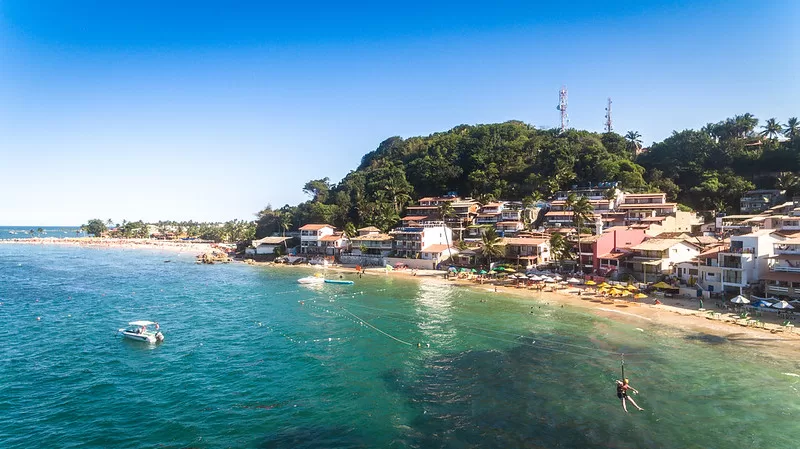Morro de São Paulo, located on Tinharé Island in the state of Bahia, is a destination that captivates tourists from around the world. With its white sandy beaches, crystal-clear waters, and an atmosphere that blends rustic charm with sophistication, it serves as a true postcard of Brazil’s biodiversity. Its rich history, culture, and natural beauty make Morro de São Paulo an exemplary model of how tourism can be a force for preservation and sustainable development when properly managed.

The Beaches of Morro de São Paulo: Diversity and Charm
The beaches of Morro de São Paulo showcase a remarkable diversity that caters to various tastes and expectations. Each beach possesses unique characteristics that contribute to the richness of this tourist destination.
Second Beach: The Most Lively
Second Beach is considered Morro de São Paulo’s most vibrant and lively spot. Known for its consistent waves, it attracts young and adult visitors seeking fun, surfing, and an energetic social scene. The presence of bars, restaurants, and kiosks along the shoreline makes it a dynamic meeting point, where live music and DJs create a festive atmosphere. Additionally, Second Beach is renowned for its natural beauty, featuring an extensive stretch of sand and warm waters, ideal for swimming and water sports.
First Beach: Movement and Tranquility
First Beach offers an interesting contrast. Despite being quite busy, it maintains a more tranquil atmosphere, making it perfect for sports, beach walks, or simply relaxing. Its infrastructure includes kiosks and bars offering a variety of food and drinks, along with a privileged view of the sea. A lookout point providing a panoramic view of the island is one of the highlights of this location, which combines physical activities with moments of rest.
Fourth Beach: Nature and Relaxation
Fourth Beach is characterized by natural pools, fishing shacks, and seaside bars. Its geological formation, with coral reefs, creates an ideal environment for snorkeling and observing marine life. It’s a perfect spot for those seeking to escape the hustle and connect with nature, enjoying a scene of tranquility and wild beauty. Its more secluded atmosphere makes it an excellent choice for families and couples looking for peace.
Garapuá: Hidden and Deserted
Almost hidden among mangroves, Garapuá is a nearly untouched beauty. With warm, crystal-clear waters and moderate depth, it serves as a refuge for those wanting to escape the crowds of more popular beaches. The presence of fishermen and minimal beach infrastructure contribute to an authentic and rustic experience. It’s an ideal location for boat trips, diving, or simply enjoying breathtaking scenery.
Gamboa: The Fishermen’s Paradise
Gamboa is a beach that preserves its traditional roots. With a fishing community that has been living off the activity for generations, it offers a unique cultural experience. Surrounded by mangroves, the beach features simple but welcoming infrastructure. Visitors can enjoy typical dishes made with fresh fish, while taking in views of the sea and mangrove areas. Gamboa is also known for its rustic guesthouses, providing an immersive experience in local culture.
Gamboa: Morro de São Paulo’s Largest Community
Most residents of Morro de São Paulo live in Gamboa, which functions as a hub for economic and cultural activities. The coexistence of tradition and modernity is evident, with shops, restaurants, and sustainable tourism initiatives. The community keeps its local culture alive through festivals, folkloric manifestations, and a strong connection to the sea.
The Importance of Tourism for Morro de São Paulo
Tourism is the primary economic activity on the island, responsible for generating employment, income, and development. The natural beauty of the beaches, combined with local culture, attracts visitors from across Brazil and around the world. However, this growth also presents challenges related to environmental preservation, infrastructure, and maintaining residents’ quality of life.
Environmental Preservation and Sustainability
Protecting beaches and marine ecosystems is essential to ensure the continuity of sustainable tourism. Coral reefs, mangroves, and marine fauna are resources that must be safeguarded from destructive human actions such as pollution, overfishing, and uncontrolled mass tourism. Environmental education programs, enforcement, and conservation initiatives are vital to balancing economic development with biodiversity preservation.
Infrastructure and Accessibility
Morro de São Paulo’s infrastructure must evolve alongside tourism growth, offering transportation, accommodation, sanitation, and quality services. Accessibility is also crucial, ensuring that people with reduced mobility can enjoy the island’s beauty. Improving access routes, proper signage, and training local professionals contribute to a more satisfying visitor experience.
Culture and Community
Local culture is a heritage that must be valued and preserved. Folkloric manifestations, traditional cuisine, and the customs of fishermen and residents enrich the tourist experience and strengthen community identity. Promoting cultural tourism and ecotourism are strategies that foster sustainable development, respecting local roots and ways of life.
Challenges and Future Perspectives
Despite its tourism potential, Morro de São Paulo faces challenges that require careful planning and responsibility. The pressure from mass tourism can lead to environmental degradation, loss of authenticity, and increased living costs for residents.
Urban Planning and Resource Management
Implementing sustainable urban planning is fundamental to prevent disorderly growth. Efficient management of natural resources, land use regulation, and promotion of responsible tourism practices are actions that ensure environmental preservation and quality of life.
Environmental Education and Community Engagement
Raising awareness among locals and visitors about the importance of environmental preservation is a powerful tool. Education programs, cleanup campaigns, and community participation initiatives strengthen commitment to sustainability.
Innovation and Tourism Diversification
Diversifying tourism activities—including ecotourism, cultural tourism, adventure tourism, and wellness tourism—broadens visitation options and reduces pressure on the most popular beaches. Investing in quality infrastructure and marketing also attracts a more conscious audience seeking authentic experiences.
Morro de São Paulo is undoubtedly one of Brazil’s most enchanting destinations—a true treasure of natural beauty, vibrant culture, and rich history. Each beach, with its unique features, offers a variety of experiences that cater to different tastes and expectations. However, for this paradise to continue enchanting future generations, a firm commitment to environmental preservation, sustainable development, and cultural strengthening is essential.
Striking a balance between economic growth and environmental conservation is the way forward for Morro de São Paulo to maintain its charm and authenticity. In doing so, the destination will remain a benchmark of beauty, culture, and sustainability—a shining example of how tourism can be a force for positive transformation, promoting community well-being and preserving natural heritage.


